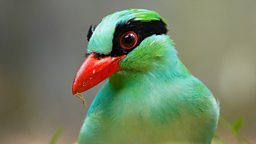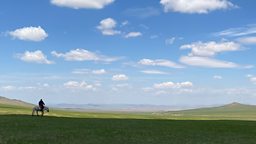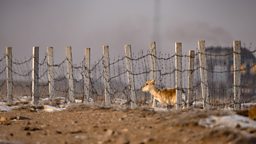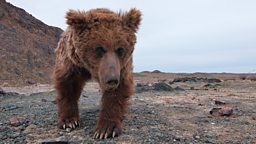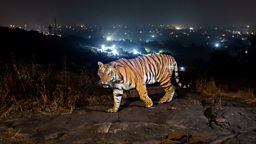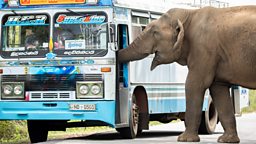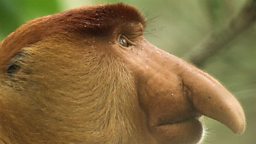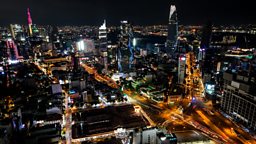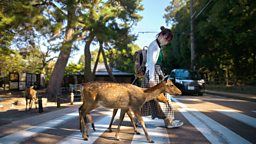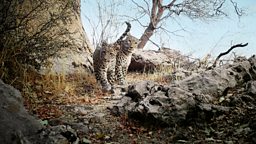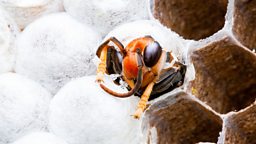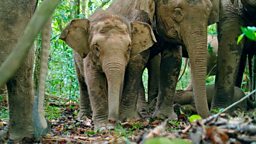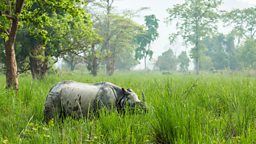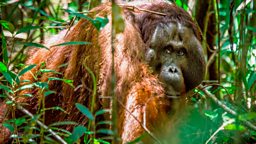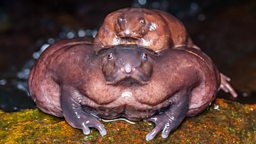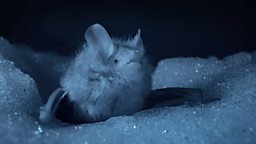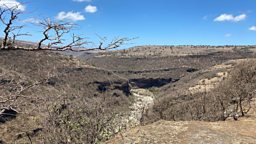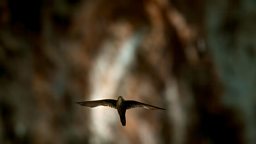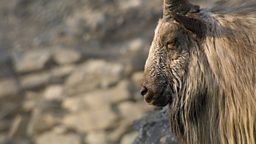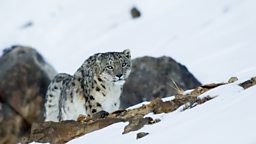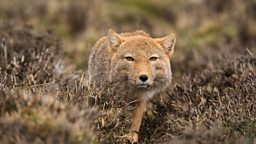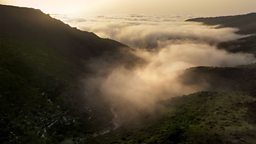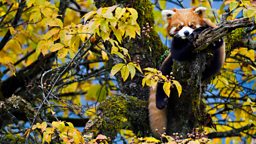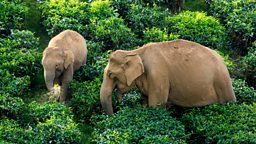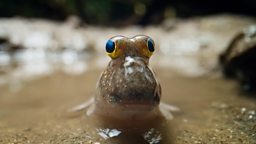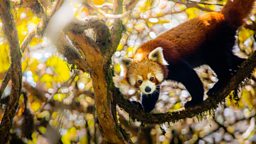Tracking India’s tea elephants
By Joseph Russell, Assistant Producer

Myself and the rest of the film crew were trapped. Our trusty van was parked nearby, but we were stuck, hiding in some bushes. A herd of Asian elephants were just a stone’s throw away, and they were agitated. A colossal gaur (a remarkably muscular species of wild cow) had startled the herd, and a protective matriarch was trumpeting loudly, leading her family closer and closer to us - the hapless ���˿��� crew tasked with filming her.
Myself and the rest of the film crew were trapped.
I saw our cameraman Ralph edging silently backwards with his camera in hand, while our guide Ganesh whispered updates on the current level of danger we were experiencing. Eventually the herd moved on, and with Ganesh’s guidance, we managed to make it back to the safety of the vehicle. When I started working on the “Above the Clouds” episode of the Asia series, I didn’t expect to be in this position…
Finding extraordinary wildlife stories in the highest places in Asia was a challenging proposition; animals at altitude are generally harder to study, their behaviours are often less understood, and many are particularly sensitive to humans (especially those armed with oversized cameras!) So imagine our surprise when we discovered tantalising photographic evidence of the largest land animal on the continent - the Asian elephant - not only navigating the steep landscape of India’s Western Ghats mountain range, but living in close proximity to a dense human population – in tea plantations, of all places. What’s more, the elephants were being actively studied by local researchers. The story seemed to have all the right ingredients.
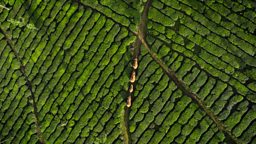
As with many of the filming trips on the “Above the Clouds” episode, just getting to our location was an adventure in itself. Driving in a minivan full of gear up the narrow road to Valparai, we sat somewhat apprehensively - we’d heard in recent weeks that a particularly bold bull elephant had taken to patrolling the trail and accosting vehicles. We were even shown some phone footage of a tuk-tuk being bullied back downhill.
...endless tea plantations, bathed in golden sunlight, with mountains looming in the distance.
But luck was on our side, and the pachyderm highwayman was nowhere to be seen - in fact it was a different local species that proved to be problematic. After hours of driving, we took a quick break to stretch our legs. Within minutes, we found ourselves absolutely covered in hungry leeches - a particularly wet monsoon had led to an explosion of the little bloodsuckers. It was definitely an unglamorous start to our month in the field.
Our spirits were lifted when we finally emerged from the forest on to the Valparai Plateau, where we would be based. The view was remarkable: apparently endless tea plantations, bathed in golden sunlight, with mountains looming in the distance.
Valparai is a hill station, nestled in an area known as the Anamalai, which means “Elephant Hills”. Given this, you’d think finding the herds would be an easy task. But the plateau extends over hundreds of square kilometres, and elephants blend surprisingly well with their surroundings. Added to this, the herds are forever on the move, in their never-ending search for food. All this made for a challenging shoot.

I must admit, that my first impression upon entering the tea plantation was that it didn’t look like great elephant habitat. While we’d been warned to look out for leopards and cobras hiding among the bushes, it was the plants themselves which gave us pause. Tea plants can grow extraordinarily sharp, their branches unyielding and sturdy. The idea that elephants would be able to travel through this tricky human-made world seemed far-fetched, but it came on good authority…
...human fatalities were commonplace here...
Ganesh Raghunathan, local researcher and conservationist, was accompanying us. He’d been following and studying the elephants in Valparai for over a decade, learning their family structures, and social behaviours and mapping their pathways through the tea fields. In short, he was an elephant whisperer.
Ganesh’s expertise came into play just days into the shoot - having finally found our first herd grazing on a tea estate, we set up our camera some 50 metres away. To our naive eyes the family seemed completely unfazed by us, relaxed in the morning sunshine, but when we asked Ganesh how much closer we could comfortably approach, he chuckled and replied that we were about as close as most sensible researchers get on foot to wild elephants, and that we’d be surprised just how quickly an adult elephant could cover 50 metres. Ganesh knew that for many years, human fatalities were commonplace here, often resulting from accidental run-ins between people and elephants. It’s a narrative echoed around the world, but no more so than here in Asia where wildlife and humanity seems to so dramatically overlap. It set the tone for our work, and definitely gave us a wary respect for the gentle giants.
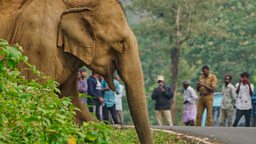
We soon came to rely on Ganesh’s network of contacts and colleagues across the plateau - it seemed like everybody from residents to shop owners, tea workers to local authorities had his number. We soon came to expect the daily phone calls tipping us off about the latest elephant sightings.
...the elephants here adapted in some ways, and doggedly persisted in others.
The longer we spent filming, the more we were captivated by the story of this burgeoning hill station, and the history of the elephant herds that call it home. Just over a century ago, British plantation owners had spearheaded the transformation of untouched montane jungle into tea fields - unpalatable to the elephants. Just like that, a swathe of one of the world’s eight ‘hottest’ biodiversity hotspots was reduced to a monoculture of tea. It was remarkable to consider that the change has happened over just a few elephant lifetimes. It is likely that the great-great-great-great-great grandmothers of the elephants we were filming, lived in a totally unrecognisable, natural world.
Faced with such a radical change to their home, the elephants here adapted in some ways, and doggedly persisted in others. They may have turned their noses up at the bitter tea leaves, but weeds growing among the tea bushes (and swamps lying between tea plantations) are very appetising. It seems that the appearance of tea plantations hasn’t dissuaded elephants from continuing to follow their ancestral walkways, which now cut straight through tea plantations. The spectacle of dozens of three-metre tall behemoths delicately making their way along narrow paths between lines of tea plants, carefully not trampling them, is something that has to be seen to be believed.

One of the most memorable filming days came towards the end of our shoot. A call came in that a herd we’d been following had entered a particular tea estate, and Ganesh knew it was likely they would cross a particular road in order to move into nearby forest. We rushed to arrive ahead of the herd, and deployed both our long-lens camera, as well as some carefully camouflaged remote cameras. The local authorities stepped in to halt traffic and manage the growing crowd - clearly excited to see the herd up close.
What struck us most about the whole event, was the tolerance and clear respect the gathered crowd had for the elephants.
In what felt like just minutes after our cameras were switched on, a matriarch's head appeared tentatively over a nearby hill. We waited with bated breath as the herd approached the boundary of the tea field, and soon enough a couple of excitable calves were edging out into the open. It’s thought that there are fewer wild Asian Elephants in the world today than humpback whales, or orangutans, so seeing a family with youngsters so close, adapting to their world so well, was a very special experience.
What struck us most about the whole event, was the tolerance and clear respect the gathered crowd had for the elephants. There was no moaning at the congestion, no anger at the extended commute to work - people of all ages seemed happy taking time out of their day, standing eagerly with phones out to record such a close encounter with these giants. Watching the footage back, the happiness and awe on a lot of faces was clear to see.
Not so long ago, the human-elephant relationship in this landscape was seen as incredibly problematic, and a constant source of worry for locals. But the ingenious implementation of a text-based early warning system, alerting residents to the location and movement of incoming herds, as well as other mitigation techniques, has now changed the narrative of this Asian wildlife story, and allowed the growing human population here to make room for the unlikeliest of mountain neighbours.
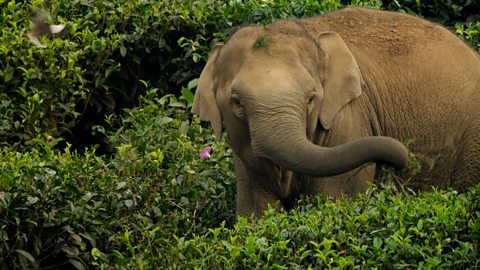
Elephants' ancient paths through tea plantations
Elephants tread old paths with care, avoiding tea and helping clear wild plants.
